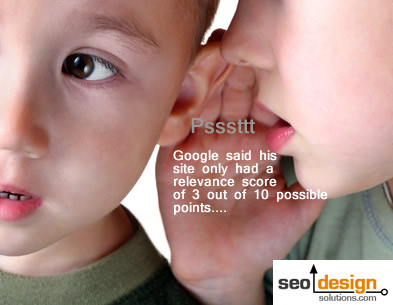 When you think of the word reputation, you immediately think of reputation management instead of managing the primary keywords your website ranks for and how search engines define your website.
When you think of the word reputation, you immediately think of reputation management instead of managing the primary keywords your website ranks for and how search engines define your website.
However as an SEO, your primary responsibilities include (a) creating a coherent and logical tiered site architecture structured to reinforce your primary theme density such as website.com/main-keyword/secondary-keyphrase.html (b) link contextually with preference of mirroring the anchor text and title of the target page [services anchor text links to services page] and (c) building or attracting relevant links to the page via deep links to cross the tipping point of on page and off page definition.
This is the process, now all you have to do is think of each page in your site as something which should convey a purpose to the viewer and also serve to support other semantically similar pages within the context of the entire site.
Each subfolder can rank for a plethora of keywords, just as each page in that subfolder or sub domain can also be fine-tuned to (1) rank for short and mid-tail keywords while (2) supporting the main landing page at the helm of the folder for the main root phrase that corresponds to the culmination of the stemmed phrases.
As a result, you also pick up the long-tail keywords which occur as a synthesis of internal anchor text preference, off page semblance as well as the fact that through information retrieval that any two or more words executed in a search query will look to find a page with the closest on page and off page prominence with exact or secondary broad match shingles.
Translation – if you have 10 pages about sales (all with a different modifier / prefix or suffix) and say for example 7 of those pages were linked with relevant anchor text to the main landing page for the folders website.com/sales/sales-landing-page1.html (2,3,4, etc.) and had an average of 50 inbound links each. Then someone conducted a search that had 3 out of those topics you could find in the sales folder (but not specific enough to toggle exact match) then either the landing page1 would be returned or the home page of the website.
However, if someone conducted a search for 3 out of 3 words that you could find in the title of any of the ten sales landing pages, then THAT PAGE would be the most relevant “exact match result”. What allows your pages to rank instead of a default home page or mid-tail close cousin to the most relevant page is the concentration of link flow and deep links to individual pages.
Managing the profile of (a) your deep link ratio and (b) the amount of concentration to any particular page from your most trafficked and relevant pages is what allows you to manage which page appears for what search term.
If you see the bulk of websites on a page when you conduct a search and you are conducting competitive intelligence, you might want to ignore the search results with the homepage (since they probably won’t convert the best anyway) and look for the result that is website.com/exact-keyword.html, php, aspx, cfm or whatever the programming platform is.
The reason why is, that page is ranking on its own merit and is further along in their optimization campaign than you may realize.
If you (1) can then sift through the quantity of deep links they have from other sites and what the anchor text is (2) look at the amount of internal deep links that they have to that page from within their own website and (3) try to assess where that page fits in the grand scheme of things (is it close to the root folder, in the root folder, 3 folders away?). If it is nested deep within a website, then you can determine that the site in question has horsepower to spare if it can push ranking factor that far away from the root and still wrap up a competitive term.
In summary, based on a metric of on page relevance and the self referral loop a page resonates, you can build a battalion of landing pages all targeting multiple keywords which can all be optimized simultaneously.
Your content, internal links and titles and your pages naming conventions are responsible for establishing your websites reputation and after links and time enter the equation (and both have an opportunity to simmer over time) the end result is an unbeatable combination of multiple strong pages all designed with a specific intent (to remain relevant, buoyant and defend themselves against other less optimized content from competitors).
The validation comes when you start to see double listings for specific keywords, mini-sitewide links with links to sub pages or other pages or eventually the one box for your main /root key phrase. When each page has a sufficient profile of internal and external link integrity, then you can leverage then to bolster new landing pages by editing the content and adding a few new links (to other concurrent keywords).
Over time with this SEO tactic, the site will assume the capability of ranking merely on a title tag, a brief mention of the keyword in a meta tags or meta description, a minor occurrence on the page or a combination of all three. The point being, relevance reinforces itself (when a search creates the vacuum from a query) and stems into converting potential topical relevance into clearly defined destinations within your website.
Just as how you link to yourself matters, managing a content development strategy that coincides with deep linking and reinforces semantic site architecture translates into building a force to be reckoned with in the SERPs (search engine result pages).
The definitive strategy goes back to (a) what type and how much content you are willing to develop to cross the tipping point and (b) how many links (from peer review) and authority sites (sites already ranking for related terms either from your own website or someone else’s) are needed to push your pages to the top 10?
The answer to that depends on who started before you, how entrenched they are across multiple algorithmic metrics and just how dedicated you are to conquering the competition and claiming a search result in the top ranking position (which can take time depending on the competitiveness of the keywords saturation in the index) and the domain authority involved.











I agreed 100% that contents are most important and one can get traffic if he/she just maintain the quality contents and frequent updates, but still people want to see little Green bar at the google toolbar. Los Angeles SEO
Thanks for great guidelines and tips
Online reputation is so tough sometimes. You just don’t know all the factors that are indeed shaping the reputation.
what plugin do you use for internal linking? can you recommend me a good plugin?
I agreed 100% that contents are most important too
bajar de peso
I am a novice in everything that has to do with SEO, but I agree that one should give a structure according to the search engines and a structure understandable to the reader.